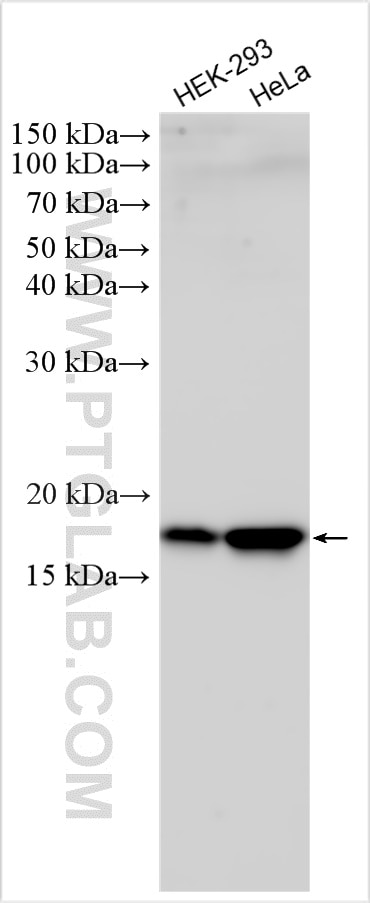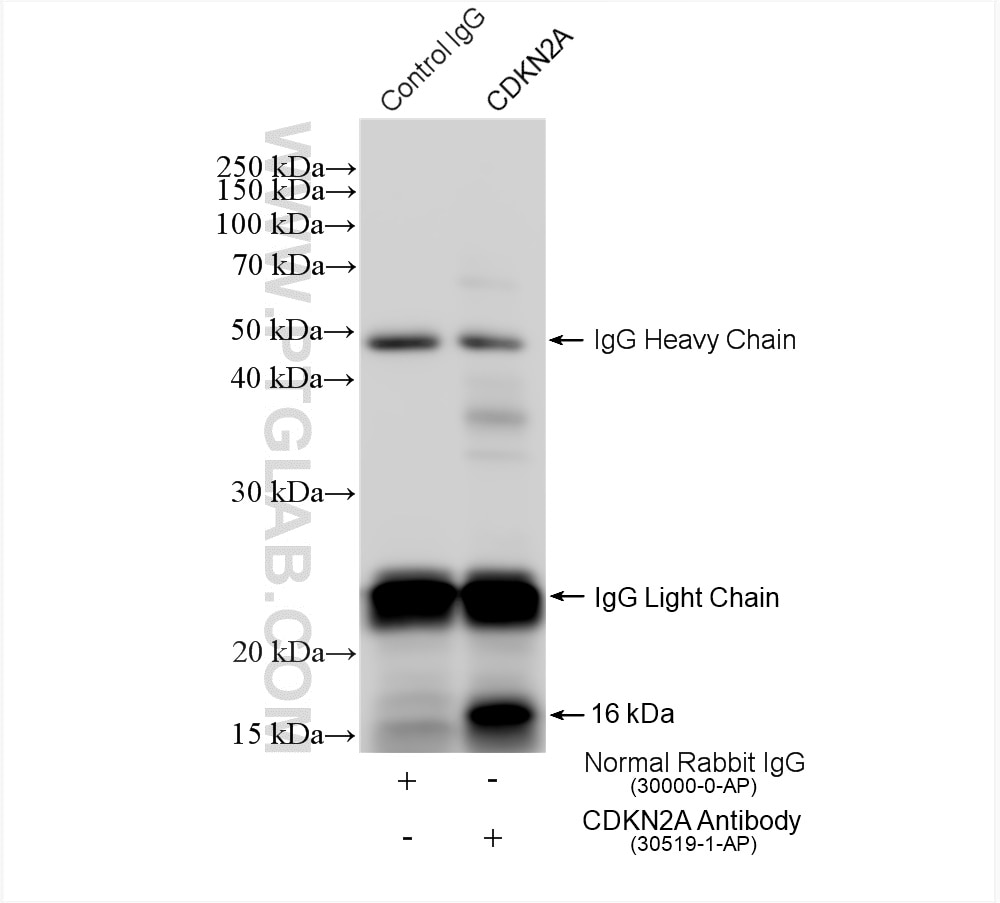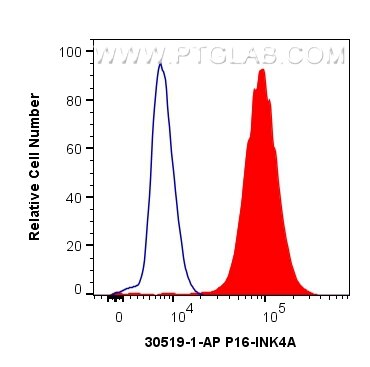CDKN2A/P16-INK4A Polyklonaler Antikörper
CDKN2A/P16-INK4A Polyklonal Antikörper für WB, FC (Intra), IP, ELISA
Wirt / Isotyp
Kaninchen / IgG
Getestete Reaktivität
human
Anwendung
WB, IHC, FC (Intra), IP, ELISA
Konjugation
Unkonjugiert
Kat-Nr. : 30519-1-AP
Synonyme
Geprüfte Anwendungen
| Erfolgreiche Detektion in WB | HEK-293-Zellen, HeLa-Zellen |
| Erfolgreiche IP | HEK-293-Zellen |
| Erfolgreiche Detektion in FC (Intra) | HeLa-Zellen |
Empfohlene Verdünnung
| Anwendung | Verdünnung |
|---|---|
| Western Blot (WB) | WB : 1:1000-1:6000 |
| Immunpräzipitation (IP) | IP : 0.5-4.0 ug for 1.0-3.0 mg of total protein lysate |
| Durchflusszytometrie (FC) (INTRA) | FC (INTRA) : 0.80 ug per 10^6 cells in a 100 µl suspension |
| It is recommended that this reagent should be titrated in each testing system to obtain optimal results. | |
| Sample-dependent, check data in validation data gallery | |
Veröffentlichte Anwendungen
| WB | See 3 publications below |
| IHC | See 1 publications below |
Produktinformation
30519-1-AP bindet in WB, IHC, FC (Intra), IP, ELISA CDKN2A/P16-INK4A und zeigt Reaktivität mit human
| Getestete Reaktivität | human |
| In Publikationen genannte Reaktivität | human |
| Wirt / Isotyp | Kaninchen / IgG |
| Klonalität | Polyklonal |
| Typ | Antikörper |
| Immunogen | CDKN2A/P16-INK4A fusion protein Ag29567 |
| Vollständiger Name | cyclin-dependent kinase inhibitor 2A |
| Berechnetes Molekulargewicht | 17 kDa |
| Beobachtetes Molekulargewicht | 16 kDa |
| GenBank-Zugangsnummer | NM_000077 |
| Gene symbol | CDKN2A |
| Gene ID (NCBI) | 1029 |
| Konjugation | Unkonjugiert |
| Form | Liquid |
| Reinigungsmethode | Antigen-Affinitätsreinigung |
| Lagerungspuffer | PBS with 0.02% sodium azide and 50% glycerol |
| Lagerungsbedingungen | Bei -20°C lagern. Nach dem Versand ein Jahr lang stabil Aliquotieren ist bei -20oC Lagerung nicht notwendig. 20ul Größen enthalten 0,1% BSA. |
Hintergrundinformationen
P16-INK4A is also named as CDKN2A, MLM, Tumor suppressor ARF, Alternative reading frame. The tumor suppressor protein p16Ink4a (encoded from the CDKN2A locus) is often transcriptionally activated in cells undergoing senescence and is one of the main regulators of this program, and it is upregulated in multiple tissues during aging (PMID:17055429). p16-Ink4a is the principal member of the Ink4 family of CDK inhibitors. p16-Ink4a contributes to the regulation of cell cycle progression by inhibiting the S phase. p16Ink4a binds to CDK4/6, inhibiting cyclin D-CDK4/6 complex formation and CDK4/6-mediated phosphorylation of Rb family members. Expression of p16-Ink4a maintains the Rb family members in a hypophosphorylated state, which promotes binding to E2F1 and leads to G1 cell cycle arrest (PMID: 21297668).
Protokolle
| PRODUKTSPEZIFISCHE PROTOKOLLE | |
|---|---|
| WB protocol for CDKN2A/P16-INK4A antibody 30519-1-AP | Protokoll herunterladen |
| IP protocol for CDKN2A/P16-INK4A antibody 30519-1-AP | Protokoll herunterladen |
| STANDARD-PROTOKOLLE | |
|---|---|
| Klicken Sie hier, um unsere Standardprotokolle anzuzeigen |
Publikationen
| Species | Application | Title |
|---|---|---|
Biochim Biophys Acta Mol Cell Res Suppression of GATA3 promotes epithelial-mesenchymal transition and simultaneous cellular senescence in human extravillous trophoblasts | ||
Aging Cell Identifying ENO1 as a protein target of chlorogenic acid to inhibit cellular senescence and prevent skin photoaging in mice | ||
Tissue Cell Molecular changes of cellular senescence in dental pulp stem cells during in vitro culture: A potential role of PSG4 | ||
Front Aging Tissue-specific effects of bacterial PncA overexpression on NAD+ metabolism and aging in mice: implications for tissue-specific aging interventions |




